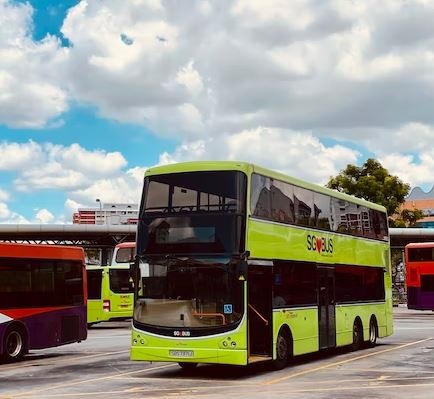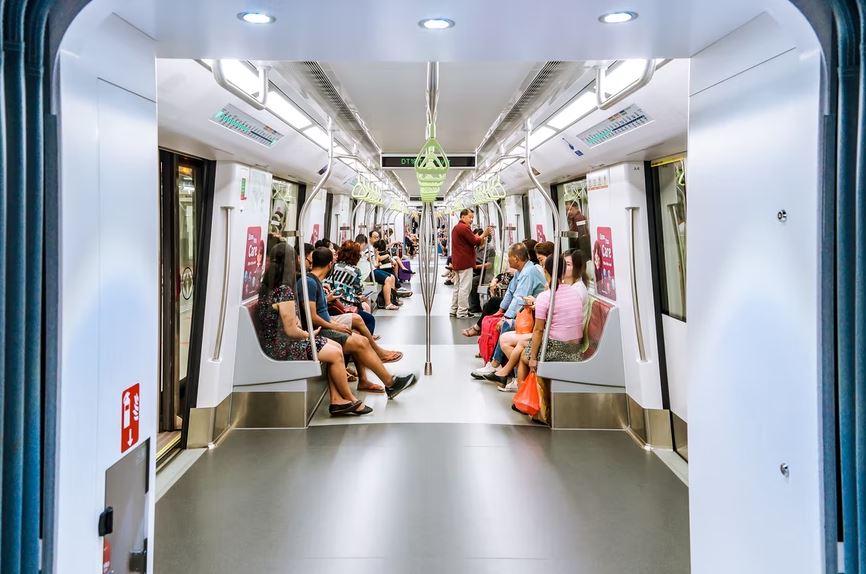Singapore has a well-designed road and transportation infrastructure that will help you navigate the city with little hassle. During your 3 days stay in Singapore, public transportation is very much needed. Public transportation is a very convenient and economical means of transportation because of its high interconnectivity and exceptional cleanliness standards. And because owning and maintaining a car is so expensive in the city, many citizens prefer to use public transportation.
Riding in MRT/LRT
The Mass Rapid Transit (MRT) system is likely the quickest and most economical way to get around town. The LRT (Light Rail Transit) system, a smaller network of trains acting as a feeder service that enables commuters to get off closer to home, is a complement to the MRT system. The majority of trains run daily between 5:30 and 12:00, with some holidays requiring longer hours. Trains typically run every 2-3 minutes in peak times and every 5-7 minutes in off-peak times.
Families with strollers, people in wheelchairs, and people who are visually impaired can all access Singapore’s trains and stations. The MRT/LRT trains are an incredibly accessible and practical mode of transportation because of their extensive network that serves a significant portion of Singapore’s neighborhoods. Standard tickets can be purchased from ticket vending machines or Ticket Offices in the MRT stations for single/return trips for short-term use. You can buy an EZ Link stored-value card that you can add money to as you use it if you plan to use it more frequently or for a longer period. In MRT stations, EZ Link cards can be purchased at Ticket Offices or Passenger Service Centers, and they can be topped off at several locations.
Riding in Bus
Singapore’s public bus system, which has a vast network of routes and covers the majority of the city, is the most affordable means of transportation. The Land Transport Authority wants all buses to be fully wheelchair accessible by 2020, and the majority of buses are equipped with ramps for accessibility.
Another benefit of Singapore’s tropical climate. Every single public bus has air conditioning. Additional public transportation bus services run by private bus companies give commuters more transportation choices. Premium Bus Services (PBS) offers a higher level of bus service with direct routes between significant housing estates and the Central Business District/industrial business parks during peak hours for those who are willing to pay a little bit more in exchange for more comfort and convenience. Additionally, the Fast Forward Bus Service runs only during rush hours, makes fewer stops, and uses more flexible routing to avoid traffic, cutting commuters’ travel times by up to 20%. Depending on the route, bus operation times range anywhere between 5:00 am and 12:00 am. You can use your EZ Link card or pay with cash, keeping your bus ticket as proof of purchase.
Riding in Taxis
Taxis are regarded as having relatively low fares compared to those of other developed countries, and they are a very convenient and comfortable way to get around Singapore (especially for getting to places that are difficult to reach by train or bus). You can ride a taxi to visit Kwan Im Vegetarian Restaurant in Singapore. Despite being in great supply, taxis sometimes become hard to find during morning and evening rush hours and on wet days. Taxis in this area are metered, but additional fees might be charged based on where and when you board, which taxi company you are using and whether you used a booking service.
Any public road outside of the Central Business District may be used to flag down a taxi at any time of day. Find a designated taxi stand or request a taxi to the closest car drop-off or pick-up location to catch a ride within the CBD. There is a booking hotline for each taxi company, and some, like Comfort Delgro, also have an app for booking. Other helpful services include UBER and GrabTaxi, which may provide more affordable rates than a traditional hailed taxi at certain times of the day.
Riding in Car
Owning a car is, of course, one of the most convenient transportation options that give you complete freedom in your plans. However, cars are considered a luxury in Singapore and are expensive to purchase and maintain. Many people can only dream of owning one. Driving in Singapore is only permitted with an International Driving Permit (IDP) and a current foreign driver’s license for short-term stays. If an IDP is unavailable, a certified English translation of the foreign license is needed. A valid Singaporean driving license must be obtained to drive in Singapore after a 12-month stay.
Transit and Walkable Ratings
You can see a Transit rating and a Walkability rating for each neighborhood in Singapore. The Transit rating indicates how effective and dependable the local public transportation system is. You can find out how walkable a neighborhood is by looking at the number of local amenities like shops, restaurants, and fitness centers that are nearby.
- Transit Ratings
Excellent: There are multiple transit options available in the area, and public transportation options like buses and trains are frequent and dependable. A car is not required.
Good: Although there is only one type of transit available in the area, it is dependable and frequent. It is not necessary to own a car for local activities.
Average: There is a public transportation option, but its regularity and dependability are insufficient for daily needs, or many locals must walk a considerable distance to get to it. It’s a good idea to have a car.
Poor: You must provide your transportation, such as a car or bicycle, as there is little to no access to public transportation in the neighborhood. Owning a car is necessary.
- Walkability Ratings
Excellent: There are plenty of options for shopping, dining, fitness, grocery stores, and other local amenities, all of which are easily accessible on foot.
Good: You can walk to the majority of the neighborhood amenities, though you might not have as many options in some areas.
Average: You can walk to a few amenities, but you’ll need to go somewhere else to meet all of your needs.
Poor: There are very few or no walking-accessible amenities; you will need to travel elsewhere for the majority of your needs.


